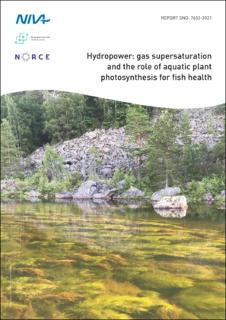| dc.contributor.author | Demars, Benoît Olivier Laurent | |
| dc.contributor.author | Dörsch, Peter | |
| dc.contributor.author | Thiemer, Kirstine | |
| dc.contributor.author | Clayer, Francois | |
| dc.contributor.author | Schneider, Susanne Claudia | |
| dc.contributor.author | Stranzl, Sebastian Franz | |
| dc.contributor.author | Pulg, Ulrich | |
| dc.contributor.author | Velle, Gaute | |
| dc.date.accessioned | 2021-06-07T13:27:17Z | |
| dc.date.available | 2021-06-07T13:27:17Z | |
| dc.date.created | 2021-06-01T14:47:49Z | |
| dc.date.issued | 2021 | |
| dc.identifier.isbn | 978-82-577-7369-4 | |
| dc.identifier.uri | https://hdl.handle.net/11250/2758247 | |
| dc.description.abstract | Fish and invertebrates breathing in water supersaturated with gas (total dissolved gas; TDG), e.g. at the outlet of hydropower plants, may develop gas bubble disease (analogous to the bends in humans). Aquatic plants also influence the gas saturation, and here we quantified to what extent the mass development of an aquatic plant (Juncus bulbosus) downstream Brokke hydropower plant in southern Norway could increase TDG and the risk for aquatic animal health. We found that J. bulbosus mass development could account for up to 5 % extra TDG supersaturation through photosynthesis, that is 105 % TDG saturation on its own. We can expect chronic health issues and acute mortality for fish and invertebrates if the added gas saturation causes the TDG supersaturation to increase to levels above a species’ tolerance, which is 110 % for acute mortality of Atlantic salmon (Salmo salar) in surface waters. Since TDG is reduced by about 10 % per meter water depth, fish may escape harmful supersaturation by moving deeper. However, the photosynthesis peak in gas saturation corresponds to surface feeding time of salmonids, so further studies in fish behaviour are required. | en_US |
| dc.language.iso | eng | en_US |
| dc.publisher | Norsk institutt for vannforskning | en_US |
| dc.relation.ispartof | NIVA-rapport | |
| dc.relation.ispartofseries | NIVA-rapport;7633 | |
| dc.subject | Vannplanter | en_US |
| dc.subject | Aquatic macrophytes | en_US |
| dc.subject | Fotosyntese | en_US |
| dc.subject | Photosynthesis | en_US |
| dc.subject | Gassovermetning | en_US |
| dc.subject | Gas supersaturation | en_US |
| dc.subject | Fisk | en_US |
| dc.subject | Fish | en_US |
| dc.title | Hydropower: gas supersaturation and the role of aquatic plant photosynthesis for fish health | en_US |
| dc.type | Research report | en_US |
| dc.description.version | publishedVersion | en_US |
| dc.rights.holder | © Norsk institutt for vannforskning / Norwegian Institute for Water Research.
© Norges Miljø- og biovitenskapelige universitet / Norwegian University of Life Sciences.
© Norwegian Research Centre AS. The publication can be cited freely if the source is stated. | en_US |
| dc.subject.nsi | VDP::Matematikk og naturvitenskap: 400 | en_US |
| dc.subject.nsi | VDP::Mathematics and natural scienses: 400 | en_US |
| dc.source.pagenumber | 23 | en_US |
| dc.source.issue | 7633 | en_US |
| dc.identifier.cristin | 1913112 | |
| cristin.ispublished | true | |
| cristin.fulltext | original | |
